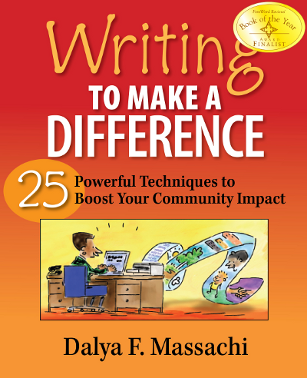[Dalya’s note: Deborah Pruitt will be featured on Writing Wednesdays 4/3/13 and has written this guest blog post. She’s the author of “Group Alchemy: The Six Elements of Highly Successful Collaboration.” In addition to heading up Group Alchemy Consulting, she serves as a faculty adviser at the Western Institute for Social Research.]
 Embarking on a collaborative writing project can be fun and interesting. You will be able to share the burden and get the benefits of different perspectives on your final product. And, as with all joint ventures, there are potential risks. Breakdowns can easily happen due to confusion, lack of agreement and differences in work styles. To keep that from happening and ensure a successful result I recommend the following six steps to success.
Embarking on a collaborative writing project can be fun and interesting. You will be able to share the burden and get the benefits of different perspectives on your final product. And, as with all joint ventures, there are potential risks. Breakdowns can easily happen due to confusion, lack of agreement and differences in work styles. To keep that from happening and ensure a successful result I recommend the following six steps to success.
1) Identify the unique pieces of the project.
Break the project into discrete segments and decide on their logical order for what you want to accomplish. This is your outline plus notes about what each segment is intended to accomplish and how it fits together with the others. Don’t be afraid to spend some time on this together – your time spent in front of the project will save you lots of revision later.
2) Identify everyone’s strengths and specialties and take advantage of them.
Create unique assignments for each of the segments of the final work.The more clearly you break the project into discrete segments the better you can identify the key components and decide who can best meet them. For instance, you’ll be most successful if you assign a budget section to someone with that experience. Or a section that focuses on program content would be best written by someone on your team who is closely involved in that program.
3) Agree on a project schedule and benchmarks for completion along the way.
Everyone needs to have a clearly defined plan so that all the pieces are ready at the right time. If one person needs information from another to complete their portion, you want to make sure that is clearly identified and a timeline agreed to.
4) Assign a project coordinator.
You can think of this person like a general contractor on a building project. You need one central person to hold all the pieces together in the big picture and keep things moving along. She or he can collect materials, answer questions, provide updates and manage deadlines. She might also determine whether a meeting is needed to clear up questions or develop the ideas to keep the project moving.
5) Assign a final editor.
Identify one or two people who will assemble all of the pieces and edit for voice, tense and general proofing. This could be the project coordinator but doesn’t need to be. Think about your strengths and choose the best editor among you for smoothing the final version into a unified and well-written piece.
6) Disseminate the final draft to all involved for review and feedback.
Once you have a complete draft ready to go, get everyone on the project to read it as a whole piece and provide feedback. This is where the benefit of multiple people can really shine. Each one of you has a particular expertise and perspective so when you read the piece you can look for the continuity and coherence around your area throughout the piece.
At the heart of each of these steps are agreements that structure and support each person doing what is needed for the project. I will be discussing the art of strong agreements that create successful collaborative projects on the April 3 Writing Wednesdays call. Please join us! If you haven’t already signed up please do so at: http://writingtomakeadifference.com/community.
Join me, Linda Lysakowski, and GiftWorks for a free webinar: Thursday, April 4th at 12 noon PDT (3 p.m. EDT)




